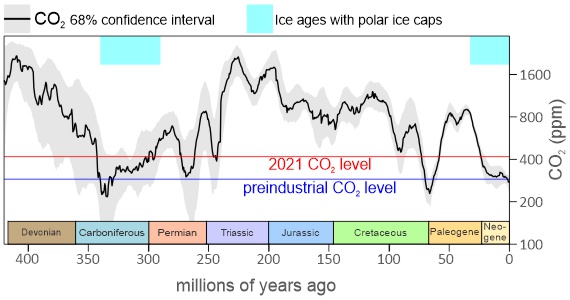 Arguments
Arguments
 Software
Software
 Resources
Comments
Resources
Comments
 The Consensus Project
The Consensus Project
 Translations
Translations
 About
Support
About
Support


Latest Posts
- Fact brief - Do solar panels generate more waste than fossil fuels?
- Zeke's 2026 and 2027 global temperature forecasts
- 2025 SkS Weekly Climate Change & Global Warming News Roundup #51
- Skeptical Science New Research for Week #51 2025
- What are the causes of recent record-high global temperatures?
- Fact brief - Are toxic heavy metals from solar panels posing a threat to human health?
- Emergence vs Detection & Attribution
- 2025 SkS Weekly Climate Change & Global Warming News Roundup #50
- Skeptical Science New Research for Week #50 2025
- The rest of the world is lapping the U.S. in the EV race
- Fact brief - Are electromagnetic fields from solar farms harmful to human health?
- Comparing climate models with observations
- 2025 SkS Weekly Climate Change & Global Warming News Roundup #49
- Skeptical Science New Research for Week #49 2025
- Climate Adam & Dr Gilbz - Paris Climate Agreement At 10: Did It Do Anything?
- Fact brief - Does the recent slowdown in Arctic sea-ice extent loss disprove human-caused warming?
- Why the chemtrail conspiracy theory lingers and grows – and why Tucker Carlson is talking about it
- 2025 SkS Weekly Climate Change & Global Warming News Roundup #48
- Skeptical Science New Research for Week #48 2025
- Consensus machines
- Just have a Think - How an African energy revolution could save ALL of us.
- A girl’s grades drop every summer. There’s an alarming explanation.
- 2025 SkS Weekly Climate Change & Global Warming News Roundup #47
- Fact brief - Are changes in solar activity causing climate change?
- Skeptical Science New Research for Week #47 2025
- Exploring newly released estimates of current policy warming
- Climate Adam - Why the Climate Crisis is a Health Crisis
- Super pollutants are trendy, but we should be careful how we use them
- 2025 SkS Weekly Climate Change & Global Warming News Roundup #46
- Skeptical Science New Research for Week #46 2025
Archived Rebuttal
This is the archived Basic rebuttal to the climate myth "CO2 was higher in the past". Click here to view the latest rebuttal.
What the science says...
|
Climate and CO2 levels have always varied together. During past ice ages CO2 levels were low, and during warm periods CO2 was higher. |
Climate and CO2 levels have always varied together. During ice ages CO2 levels were low, and during warm periods CO2 was higher. In the Eocene (56-34 million years ago) there were no polar ice caps, temperatures were about 10ºC hotter than the 20th Century, and CO2 was about 1,500ppm (Westerhold et al. 2020, Rae et al. 2021). During the last Ice Age, CO2 varied between about 180 and 300ppm as ice sheets waxed and waned with orbital wobbles (Rae et al. 2021). CO2 was also about that level during the Paleozoic Ice Age, 340-290 million years ago (Foster et al. 2017).
Early attempts to estimate CO2 for that long ago in Earth’s past were broad-brush and very uncertain (eg Royer 2006), leading to the high CO2 estimates referred to in the myth. New data and refined techniques have since clarified the picture considerably. The 2006 estimates, for example, averaged data across 10-million-year timesteps, the 2017 data in the figure below used 0.5-million-year timesteps, and newer compilations don’t average across timesteps. At the same time, CO2 and temperature uncertainties have reduced considerably so that climates from the geological past are now a useful reality check for climate models (Tierney et al. 2020, IPCC 2021, see the intermediate version for more detail).
Data for the Ordovician are still quite uncertain, but they indicate CO2 was about 2,400ppm and falling before the end-Ordovician glaciation (Pancost et al. 2013). Glaciation at higher CO2 levels than today was possible at that time for a variety of reasons including a less-bright Sun back then (see the intermediate version). The Jurassic and Cretaceous span 134 million years with several hothouse episodes and several cooler episodes, with CO2 varying from about 600ppm to about 1500ppm accordingly (Witkowski et al. 2018), but there was no glaciation in that time.
Earth’s long-term climate (over millions of years) is governed by the balance between CO2 emitted into the atmosphere by volcanoes and CO2 removed from the atmosphere by weathering of rocks (Joel 2017). This has prevented runaway climates and kept Earth’s climate generally habitable for about 4 billion years, but it can be outpaced by abrupt greenhouse gas releases (e.g. at the end-Permian mass extinction), or removals (e.g. “Snowball Earth” periods).
CO2 levels for the last 420 million years, showing periods with ice ages. Note this curve is smoothed and too low resolution to show spikes in CO2, eg at the end-Permian, end-Cretaceous, PETM, etc. Data from Foster et al. nature communications 2017. Late Paleozoic Ice Age per Rolland et al. EPSL 2019. Preindustrial CO2 278 ppm, 2021 CO2 420ppm (CO2.Earth). Newer data zooming in on the last 66 million years can be found on the intermediate tab.
Updated on 2015-07-06 by pattimer.
THE ESCALATOR

(free to republish)

























































